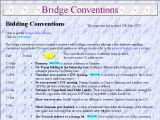| to news-sheet main page |
 |
||
| to bridge conventions | |||
| to Pattaya Bridge home page |
|||
Mon 16th 1st Janne & Lasse 68% 2nd Gene & Bengt 60%
Wed 18th 1st Henrik & Terje 67% 2nd Janne & Lasse 56%
Fri 20th 1st (individual) Ivy 61% = 2nd Phil, Dave 58%
Bidding Quiz Standard American is assumed unless
otherwise stated.
Hand A Hand B With Hand A partner opens 1♥ and you respond 1♠. Partner
then
bids 2♦, what do you bid?
♠ KQ108643 ♠ A8653
♣
3 ♣ 43 you
do now?
Bidding Sequences Quiz All of these sequences occurred this
week
Dealer: ♠ A76
Love all ♦ K92 - 1♥ pass 1♠
♣
8 pass 3♥ (1) pass 4NT
pass 5♠ (2) pass 6♥ (3)
♠ 843
N ♠ Q105
♥ A65
W E ♥ 107 (1) A bit of an overbid, but North’s ♥ suit is
♠
KJ92 (2) 2 keycards + the ♥Q
♥ 32 (3) With miserable trumps and tenaces galore,
♦ AJ3 6NT
may be a better bid.
E-W vul ♦ 94 2♠ pass 3♦ (2) pass
♣
K7 3♠ all
pass
♠ J94
N ♠ A8653 (1) What did you open with this East hand B(a)
♥ 975
W E ♥ AK in this week’s quiz? 5242 is not balanced,
but
♠
107 (2) But here we see the problem – should East now
♥ Q84 make a try for game? What did you bid with
♦ K1087 this
East hand B(b) in this week’s quiz?
♠ KJ97
N ♠
Q865 You are West, declarer in 6♠. You win the ♥Q
♥ 83 W E ♥ AK4 lead
and lead a small ♠ to the ♠K
which North
Dealer: ♠ A You open 1NT with the West hand and after a
West ♥ QJ1052 Stayman sequence
you reach the excellent 6♠.
Love all ♦ 987 You win
the opening lead in dummy and try a
♠ KJ97
N ♠
Q865 dummy, what do you do next?
♥ 83 W E ♥ AK4
♠
10432
♥ 976 Tip:
When a defender plays a card, do not assume
♦ 105 that all
combinations containing that card are
Dealer: ♠ KQ108643 Table A
E-W vul ♦ AQ92 - - pass 1♥
♣
3 pass 1♠ pass 2♦
pass 4♠ (1) all pass
♠ J52
N ♠ A97
♥ K62
W E ♥ J1074 Table B
♠
- pass 1♠ pass 2♦
♥ A9853 pass 3♠ (1) pass 3NT
♦ K8543 pass pass (2)
Bidding Sequence Quiz Answers
♠ KJ52 You
hold this hand and partner opens 1♣.
Unless you are a Walsh player
♥ 62 (which I don’t really want to
go into as Lewis is the only club member other